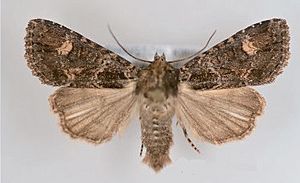Rusty shoulder knot moth facts for kids
Quick facts for kids Rusty shoulder knot moth |
|
|---|---|
 |
|
| Male | |
 |
|
| Female | |
| Scientific classification | |
| Kingdom: | |
| Phylum: | |
| Class: | |
| Order: | |
| Family: | |
| Genus: |
Aseptis
|
| Species: |
A. binotata
|
| Binomial name | |
| Aseptis binotata (Walker, 1865)
|
|
| Synonyms | |
|
|
The rusty shoulder knot moth, also known as Aseptis binotata, is a type of moth. It belongs to the Noctuidae family, which includes many different kinds of moths. This moth was first described by a scientist named Francis Walker in 1865.
You can find the rusty shoulder knot moth across western North America. It lives in places like Alberta, Wyoming, and Nebraska. Along the Pacific Coast, it ranges from northern Mexico all the way up to southern British Columbia. These moths can live in many different environments, from thick forests to dry shrub deserts. They are found from sea level up to heights of over 2,000 meters (about 6,500 feet).
Contents
What Does the Rusty Shoulder Knot Moth Look Like?
The rusty shoulder knot moth has a wingspan of about 29.5 to 35 millimeters. That's roughly the length of a few quarters lined up! This moth is quite unique because its forewing color and patterns can change a lot.
How Does Its Appearance Change?
The color of its wings can vary depending on where it lives. Some moths might be brownish, while others are dark brown, gray-brown, or even reddish-brown.
Special Markings on Its Wings
On darker moths, you might notice a large, pale yellowish patch. This patch is called the postreniform patch. A dark line, called the postmedial line, cuts right through it. Another line, the antemedial line, is curved and filled with a light tan color.
You might also see some black markings on the forewing. These include wedge shapes near the outer edge and outlines of three spots. Most moths also have a short black dash at the base of their wings. Lighter-colored moths might have faded patterns or strong, contrasting dark marks.
When Can You See These Moths?
The time of year when these moths fly depends on their location. In warmer southern areas, they start flying in March in lower places. In the mountains, they fly from April to July. In the northern parts of their range, they start flying later in the year and can be seen until August.
What Do Rusty Shoulder Knot Moths Eat?
The young moths, called larvae (or caterpillars), eat leaves from various broadleaf trees and shrubs.
Favorite Food Plants
Some of their favorite plants include:
- Big-leaf maple
- Ocean spray
- Different types of Ceanothus plants
Other plants they have been seen eating are Oemleria, Symphoricarpos, and Ribes species.
What Do the Larvae Look Like?
The larvae of the rusty shoulder knot moth are green. They have a cool stripe along their side that is both white and red.

